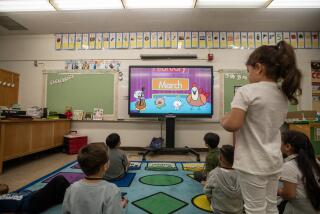School of Tradition : Lithuanian Descendants Rediscover Past, Keep Heritage Alive by Learning Language, Culture of Their Ancestors
- Share via
LOS ANGELES — It’s Saturday morning, and 3-year-old Laura Ellner would normally be home in Anaheim Hills watching her favorite cartoons.
But on this day, the wide-eyed girl is sitting in a circle at the largest Lithuanian school in the United States, listening to stories of her heritage and writing her name in large colored letters in a language that is foreign to her. It is the language of her ancestors.
So began the new school year last weekend at St. Casimir’s Lithuanian Catholic Church in Los Feliz, where Laura and about 130 other students, both young and old, are seeking out their past during a period of historic change.
This is a ritual that Laura and her mother will continue each Saturday morning through June, making the young girl the second generation in her family to spend part of the weekend learning the Lithuanian language and culture.
Her mother, 34-year-old Vida Slapelis Ellner, spent her Saturdays the same way during her childhood in New York. “All our friends used to watch cartoons, and we’d have to come to Lithuanian class,” she said.
But as long as those mornings sometimes seemed, the American-born woman says now that keeping the language and culture of her ancestry alive is as important to her as it was to her Lithuanian-born parents--especially in the wake of Baltic independence.
“It’s not easy,” she says. “It takes a commitment.”
And so, Ellner plans to drive Laura from Anaheim Hills to the school each Saturday by 9 a.m., staying there to talk with other Lithuanian-American parents until classes let out four hours later.
“It’s a joyous occasion,” school co-principal Maryte Newsom, a resident of West Los Angeles, told students and families in welcoming them Saturday.
“This time it’s a different opening of the school because of the freedom in Lithuania,” she said. “The work has just begun, and don’t think on Saturday you can snuggle in your cozy beds to watch cartoons. Now we really have to learn Lithuanian well.”
Not only was Saturday the school’s first day of the year, it was a day for the Lithuanian-American community to celebrate a realized dream for the “old country,” as U.S. Secretary of States James A. Baker III toured the Baltics to offer support to the newly independent states of Estonia, Lithuania and Latvia.
The three small republics were seized by Soviet dictator Josef Stalin in 1940 but, after years of struggle, have now been able to gain their freedom amid the dramatic collapse of the Soviet Union’s system of rule.
Southern California’s estimated 60,000 Lithuanian-Americans have cheered the developments, and some at St. Casimir’s school say they now plan to return to Lithuania to visit or study. At the very least, they say, independence should mean easier communications with family members and friends still living in the Baltics.
School co-principal Algimantas Zemaitaitis, 59, who left Lithuania at age 12, says the school will now need to reassess its own goals and practices as the dream of independence has moved from “fairy tale” to reality.
“The language will be easier to teach because most of the students will be going back to visit,” he said. “A number of our restless young people have become quite patriotic.”
On Saturday, parents, students and school officials displayed their excitement over the recent turn of events, with some wearing shirts that were decorated with ribbons in the gold, green and red colors of the Lithuanian flag.
Before welcoming speeches were made, the descendants, whose heritage is predominantly Roman Catholic, gathered in the church altar for Mass and to give thanks for what seemed a miraculous change in history.
After the service, they said they are now more determined than ever to teach Lithuanian descendants the language of their ancestors and offer whatever help they can to those left behind in their homeland.
“I want to carry (the language) on to my kids,” student Danyte Mockus, 21, of San Diego said.
Mockus understood Lithuanian as a child from listening to her parents and grandparents but never learned how to speak the language until last year, when she started attending classes at the Saturday school.
“I want my children to know where they came from,” she said. “Everybody has a background from somewhere and they should know about it.”
The school opened in 1949, co-principal Newsom said. Most of its students now come from Orange and Los Angeles counties, while some families make the drive from as far as San Diego or Santa Barbara.
It is the only Lithuanian school on the West Coast, according to school officials, and its pupil population of about 130 makes it the largest Lithuanian school out of the 30 such schools in America.
Each student, from pre-kindergartners to adults, pays $180 a year to help pay rent at the church and stipends for the 20 teachers. Besides Lithuanian grammar and literature, subjects include history, folk dancing and music. Most of the classes are held in Lithuanian, but there are two where English is spoken.
“This is one opportunity to see other people who speak the language,” said Ron Popenhagen, 38, who drives his 2-year-old son, Darius, from their home in Santa Barbara.
Leon Vaitaitis, 36, of Mission Viejo said the school is preparing his daughter, 5-year-old Vilija, for visits to Lithuania.
“We have a lot of relatives there. If they ever meet, they should be able to communicate,” said Vaitaitis, whose 2-year-old son, Nicholas, will start studying Lithuanian next year and learn folk dances and other traditional customs.
Under the guidance of several teachers, students danced in a circle in the church courtyard Saturday to the accompaniment of piano and song. At times, the dance required pupils to pair off and circle around each other while holding hands above their heads--a slower form of square dancing. At 11:45 a.m., there was a break for pizza and milk.
Throughout the day, adults and children--even while playing during recess--stuck to Lithuanian and only spoke in English when necessary.
“Everything we do revolves around Lithuania,” said Tara Barauskas, a 19-year-old resident of La Mirada. “We write letters to the President and Congress (to encourage U.S. recognition of Lithuania), we watch the news, we correspond with people in Lithuania.”
Barauskas decided to help teach the pre-kindergarten class at the Lithuanian school after just finishing as a student herself. She began her studies at the school in the third grade.
“My parents made me at first. Then I wanted to stay because of my friends,” Barauskas said as she helped two girls with their coloring. “It was hard, though. I used to throw temper tantrums about coming here.”
But her feelings have changed over the years, and she is glad the Lithuanian school still exists to keep her heritage alive.
More to Read
Sign up for Essential California
The most important California stories and recommendations in your inbox every morning.
You may occasionally receive promotional content from the Los Angeles Times.













